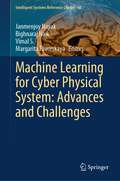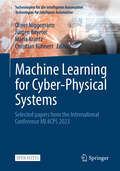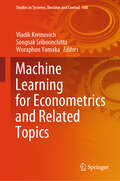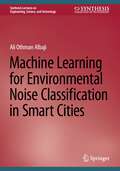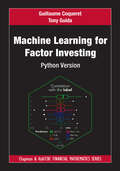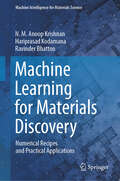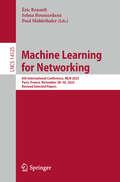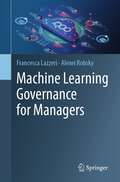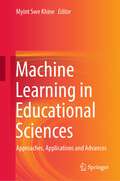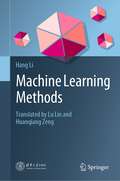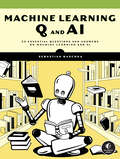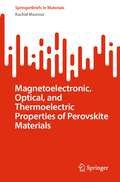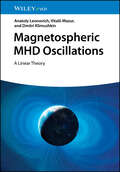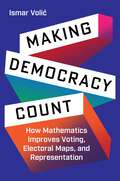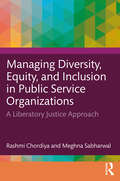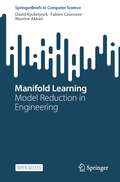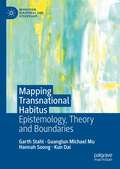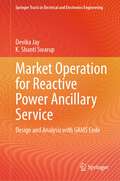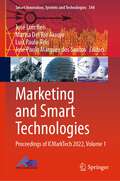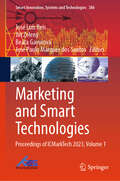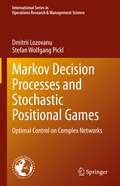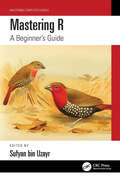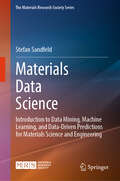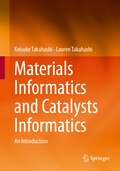- Table View
- List View
Machine Learning for Cyber Physical System: Advances and Challenges (Intelligent Systems Reference Library #60)
by Janmenjoy Nayak Bighnaraj Naik Vimal S. Margarita FavorskayaThis book provides a comprehensive platform for learning the state-of-the-art machine learning algorithms for solving several cybersecurity issues. It is helpful in guiding for the implementation of smart machine learning solutions to detect various cybersecurity problems and make the users to understand in combating malware, detect spam, and fight financial fraud to mitigate cybercrimes. With an effective analysis of cyber-physical data, it consists of the solution for many real-life problems such as anomaly detection, IoT-based framework for security and control, manufacturing control system, fault detection, smart cities, risk assessment of cyber-physical systems, medical diagnosis, smart grid systems, biometric-based physical and cybersecurity systems using advance machine learning approach. Filling an important gap between machine learning and cybersecurity communities, it discusses topics covering a wide range of modern and practical advance machine learning techniques, frameworks, and development tools to enable readers to engage with the cutting-edge research across various aspects of cybersecurity.
Machine Learning for Cyber-Physical Systems: Selected papers from the International Conference ML4CPS 2023 (Technologien für die intelligente Automation #18)
by Jürgen Beyerer Oliver Niggemann Christian Kühnert Maria KrantzThis open access proceedings presents new approaches to Machine Learning for Cyber-Physical Systems, experiences and visions. It contains some selected papers from the international Conference ML4CPS – Machine Learning for Cyber-Physical Systems, which was held in Hamburg (Germany), March 29th to 31st, 2023. Cyber-physical systems are characterized by their ability to adapt and to learn: They analyze their environment and, based on observations, they learn patterns, correlations and predictive models. Typical applications are condition monitoring, predictive maintenance, image processing and diagnosis. Machine Learning is the key technology for these developments.This is an open access book.
Machine Learning for Econometrics and Related Topics (Studies in Systems, Decision and Control #508)
by Vladik Kreinovich Songsak Sriboonchitta Woraphon YamakaIn the last decades, machine learning techniques – especially techniques of deep learning – led to numerous successes in many application areas, including economics. The use of machine learning in economics is the main focus of this book; however, the book also describes the use of more traditional econometric techniques. Applications include practically all major sectors of economics: agriculture, health (including the impact of Covid-19), manufacturing, trade, transportation, etc. Several papers analyze the effect of age, education, and gender on economy – and, more generally, issues of fairness and discrimination.We hope that this volume will:help practitioners to become better knowledgeable of the state-of-the-art econometric techniques, especially techniques of machine learning,and help researchers to further develop these important research directions. We want to thank all the authors for their contributions and all anonymous referees for their thorough analysis and helpful comments.
Machine Learning for Environmental Noise Classification in Smart Cities (Synthesis Lectures on Engineering, Science, and Technology)
by Ali Othman AlbajiWe present a Machine Learning (ML) approach to monitoring and classifying noise pollution. Both methods of monitoring and classification have been proven successful. MATLAB and Python code was generated to monitor all types of noise pollution from the collected data, while ML was trained to classify these data. ML algorithms showed promising performance in monitoring the different sound classes such as highways, railways, trains and birds, airports and many more. It is observed that all the data obtained by both methods can be used to control noise pollution levels and for data analytics. They can help decision making and policy making by stakeholders such as municipalities, housing authorities and urban planners in smart cities. The findings indicate that ML can be used effectively in monitoring and measurement. Improvements can be obtained by enhancing the data collection methods. The intention is to develop more ML platforms from which to construct a less noisy. The second objective of this study was to visualize and analyze the data of 18 types of noise pollution that have been collected from 16 different locations in Malaysia. All the collected data were stored in Tableau software. Through the use of both qualitative and quantitative measurements, the data collected for this project was then combined to create a noise map database that can help smart cities make informed decisions.
Machine Learning for Factor Investing: Python Version (Chapman and Hall/CRC Financial Mathematics Series)
by Guillaume Coqueret Tony GuidaMachine learning (ML) is progressively reshaping the fields of quantitative finance and algorithmic trading. ML tools are increasingly adopted by hedge funds and asset managers, notably for alpha signal generation and stocks selection. The technicality of the subject can make it hard for non-specialists to join the bandwagon, as the jargon and coding requirements may seem out-of-reach. Machine learning for factor investing: Python version bridges this gap. It provides a comprehensive tour of modern ML-based investment strategies that rely on firm characteristics. The book covers a wide array of subjects which range from economic rationales to rigorous portfolio back-testing and encompass both data processing and model interpretability. Common supervised learning algorithms such as tree models and neural networks are explained in the context of style investing and the reader can also dig into more complex techniques like autoencoder asset returns, Bayesian additive trees and causal models. All topics are illustrated with self-contained Python code samples and snippets that are applied to a large public dataset that contains over 90 predictors. The material, along with the content of the book, is available online so that readers can reproduce and enhance the examples at their convenience. If you have even a basic knowledge of quantitative finance, this combination of theoretical concepts and practical illustrations will help you learn quickly and deepen your financial and technical expertise.
Machine Learning for Materials Discovery: Numerical Recipes and Practical Applications (Machine Intelligence for Materials Science)
by Hariprasad Kodamana Ravinder Bhattoo N. M. KrishnanFocusing on the fundamentals of machine learning, this book covers broad areas of data-driven modeling, ranging from simple regression to advanced machine learning and optimization methods for applications in materials modeling and discovery. The book explains complex mathematical concepts in a lucid manner to ensure that readers from different materials domains are able to use these techniques successfully. A unique feature of this book is its hands-on aspect—each method presented herein is accompanied by a code that implements the method in open-source platforms such as Python. This book is thus aimed at graduate students, researchers, and engineers to enable the use of data-driven methods for understanding and accelerating the discovery of novel materials.
Machine Learning for Networking: 6th International Conference, MLN 2023, Paris, France, November 28–30, 2023, Revised Selected Papers (Lecture Notes in Computer Science #14525)
by Selma Boumerdassi Éric Renault Paul MühlethalerThis book constitutes the refereed proceedings of the 6th International Conference on Machine Learning for Networking, MLN 2023, held in Paris, France, during November 28–30, 2023. The 18 full papers included in this book were carefully reviewed and selected from 34 submissions. The conference aims at providing a top forum for researchers and practitioners to present and discuss new trends in machine learning, deep learning, pattern recognition and optimization for network architectures and services.
Machine Learning Governance for Managers
by Francesca Lazzeri Alexei RobskyMachine Learning Governance for Managers provides readers with the knowledge to unlock insights from data and leverage AI solutions. In today's business landscape, most organizations face challenges in scaling and maintaining a sustainable machine learning model lifecycle. This book offers a comprehensive framework that covers business requirements, data generation and acquisition, modeling, model deployment, performance measurement, and management, providing a range of methodologies, technologies, and resources to assist data science managers in adopting data and AI-driven practices. Particular emphasis is given to ramping up a solution quickly, detailing skills and techniques to ensure the right things are measured and acted upon for reliable results and high performance. Readers will learn sustainable tools for implementing machine learning with existing IT and privacy policies, including versioning all models, creating documentation, monitoring models and their results, and assessing their causal business impact. By overcoming these challenges, bottom-line gains from AI investments can be realized. Organizations that implement all aspects of AI/ML model governance can achieve a high level of control and visibility over how models perform in production, leading to improved operational efficiency and a higher ROI on AI investments. Machine Learning Governance for Managers helps to effectively control model inputs and understand all the variables that may impact your results. Don't let challenges in machine learning hinder your organization's growth - unlock its potential with this essential guide.
Machine Learning in Educational Sciences: Approaches, Applications and Advances
by Myint Swe KhineThis comprehensive volume investigates the untapped potential of machine learning in educational settings. It examines the profound impact machine learning can have on reshaping educational research. Each chapter delves into specific applications and advancements, sheds light on theory-building, and multidisciplinary research, and identifies areas for further development. It encompasses various topics, such as machine-based learning in psychological assessment. It also highlights the power of machine learning in analyzing large-scale international assessment data and utilizing natural language processing for science education. With contributions from leading scholars in the field, this book provides a comprehensive, evidence-based framework for leveraging machine-learning approaches to enhance educational outcomes. The book offers valuable insights and recommendations that could help shape the future of educational sciences.
Machine Learning Methods
by Hang LiThis book provides a comprehensive and systematic introduction to the principal machine learning methods, covering both supervised and unsupervised learning methods. It discusses essential methods of classification and regression in supervised learning, such as decision trees, perceptrons, support vector machines, maximum entropy models, logistic regression models and multiclass classification, as well as methods applied in supervised learning, like the hidden Markov model and conditional random fields. In the context of unsupervised learning, it examines clustering and other problems as well as methods such as singular value decomposition, principal component analysis and latent semantic analysis. As a fundamental book on machine learning, it addresses the needs of researchers and students who apply machine learning as an important tool in their research, especially those in fields such as information retrieval, natural language processing and text data mining. In order to understand the concepts and methods discussed, readers are expected to have an elementary knowledge of advanced mathematics, linear algebra and probability statistics. The detailed explanations of basic principles, underlying concepts and algorithms enable readers to grasp basic techniques, while the rigorous mathematical derivations and specific examples included offer valuable insights into machine learning.
Machine Learning Q and AI: 30 Essential Questions and Answers on Machine Learning and AI
by Sebastian RaschkaLearn the answers to 30 cutting-edge questions in machine learning and AI and level up your expertise in the field.If you&’re ready to venture beyond introductory concepts and dig deeper into machine learning, deep learning, and AI, the question-and-answer format of Machine Learning Q and AI will make things fast and easy for you, without a lot of mucking about.Born out of questions often fielded by author Sebastian Raschka, the direct, no-nonsense approach of this book makes advanced topics more accessible and genuinely engaging. Each brief, self-contained chapter journeys through a fundamental question in AI, unraveling it with clear explanations, diagrams, and hands-on exercises.WHAT'S INSIDE:FOCUSED CHAPTERS: Key questions in AI are answered concisely, and complex ideas are broken down into easily digestible parts.WIDE RANGE OF TOPICS: Raschka covers topics ranging from neural network architectures and model evaluation to computer vision and natural language processing.PRACTICAL APPLICATIONS: Learn techniques for enhancing model performance, fine-tuning large models, and more.You&’ll also explore how to:• Manage the various sources of randomness in neural network training• Differentiate between encoder and decoder architectures in large language models• Reduce overfitting through data and model modifications• Construct confidence intervals for classifiers and optimize models with limited labeled data• Choose between different multi-GPU training paradigms and different types of generative AI models• Understand performance metrics for natural language processing• Make sense of the inductive biases in vision transformersIf you&’ve been on the hunt for the perfect resource to elevate your understanding of machine learning, Machine Learning Q and AI will make it easy for you to painlessly advance your knowledge beyond the basics.
Magnetoelectronic, Optical, and Thermoelectric Properties of Perovskite Materials (SpringerBriefs in Materials)
by Rachid MasrourThis book undertakes an extensive exploration of manganese-based compounds, such as T₁₋ₓSrxMnO₃ (T = La, Pr; x = 0.35, 0.25) using density functional theory and Monte Carlo simulations with a focus on understanding their electronic, magnetic, and magnetocaloric properties. Ba₁₋ₓSrxFeO₃ (x = 0, 0.2) is also studied via different approximations, offering a comparative perspective. In addition, the book looks at the influence of magnetism using Monte Carlo simulations, revealing crucial parameters and examining the GdCrO₃ system through DFT and Monte Carlo simulation, shedding light on recent experimental observations. Additionally, Monte Carlo studies investigate magnetic and magnetocaloric features of Sr₂FeMoO₆, La₂SrMn₂O₇ bilayer manganite, perovskite ferromagnetic thin films' surface effects, and SmFe₁₋ₓMnxO₃ perovskite. In essence, this book significantly advances our comprehension of magnetic and magnetocaloric phenomena across diverse materials and is well-suited for both experimentalists and computational researchers working in this field.
Magnetospheric MHD Oscillations: A Linear Theory
by Anatoly Leonovich Dmitri Klimushkin Vitalii MazurMagnetospheric MHD Oscillations A groundbreaking new theory of the magnetosphere The magnetosphere is the region around Earth in which our planet’s magnetic field exerts its influence to trap charged particles. Waves in this magnetosphere, known as magnetohydrodynamic (MHD) oscillations, are caused by interactions between these charged particles, Solar wind pulses, and the magnetic field. The predictable interval between these oscillations enables them to serve as tools for understanding the magnetospheric plasma which comprises the field. Magnetospheric MHD Oscillations offers a comprehensive overview of the theory underlying these waves and their periodicity. Emphasizing the spatial structure of the oscillations, it advances a theory of MHD oscillation that promises to have significant ramifications in astronomy and beyond. Magnetospheric MHD Oscillations readers will also find: Theorizing of direct relevance to current satellite missions, such as THEMIS and the Van Allen Probe In-depth discussion of topics including Alfven resonance, waveguides in plasma filaments, and many more Detailed appendices including key calculations and statistical parameters Magnetospheric MDH Oscillations is ideal for plasma physicists, theoretical physicists, applied mathematicians, and advanced graduate students in these and related subfields.
Making and Saving Money: Jobs, Taxes, Inflation... And Much More! (A True Book (Relaunch))
by Janet Liu Melinda LiuA series to build strong financial habits early on in life!Knowing about different jobs and how to make the most of their earnings are just two critical financial literacy skills that all kids should have. Did you know that doctors have some of the highest paying jobs in the United States? Or that just 39 percent of kids in America have a savings account? Learn all this and more in Making and Saving Money - a book that gives kids insight into how our economy works.ABOUT THE SERIES:How can I make money? What is inflation? What is the difference between a debit card and a credit card? Economics - and more specifically, money - play such a large role in our lives. Yet there are many mysteries and misconceptions surrounding the basic concepts of finance and smart money management. This set of True Books offers students the know-how they'll need to start on the road to financial literacy-a crucial skill for today's world. Interesting information is presented in a fun, friendly way-and in the simplest terms possible-which will enable students to build strong financial habits early on in life.
Making Democracy Count: How Mathematics Improves Voting, Electoral Maps, and Representation
by Ismar VolićHow we can repair our democracy by rebuilding the mechanisms that power itWhat’s the best way to determine what most voters want when multiple candidates are running? What’s the fairest way to allocate legislative seats to different constituencies? What’s the least distorted way to draw voting districts? Not the way we do things now. Democracy is mathematical to its very foundations. Yet most of the methods in use are a historical grab bag of the shortsighted, the cynical, the innumerate, and the outright discriminatory. Making Democracy Count sheds new light on our electoral systems, revealing how a deeper understanding of their mathematics is the key to creating civic infrastructure that works for everyone.In this timely guide, Ismar Volić empowers us to use mathematical thinking as an objective, nonpartisan framework that rises above the noise and rancor of today’s divided public square. Examining our representative democracy using powerful clarifying concepts, Volić shows why our current voting system stifles political diversity, why the size of the House of Representatives contributes to its paralysis, why gerrymandering is a sinister instrument that entrenches partisanship and disenfranchisement, why the Electoral College must be rethought, and what can work better and why. Volić also discusses the legal and constitutional practicalities involved and proposes a road map for repairing the mathematical structures that undergird representative government.Making Democracy Count gives us the concrete knowledge and the confidence to advocate for a more just, equitable, and inclusive democracy.
Managing Diversity, Equity, and Inclusion in Public Service Organizations: A Liberatory Justice Approach
by Meghna Sabharwal Rashmi ChordiyaManaging Diversity, Equity, and Inclusion in Public Service Organizations: A Liberatory Justice Approach is a textbook designed to facilitate critical and courageous conversations that recognize our differences, including our privileged and marginalized social identities, and engage readers in the principles and practice of solidarity to transform systems of oppression. Examining dimensions of race, gender, sexual orientation, disabilities, and their intersectionality in the context of diverse, multigenerational organizations, this leading-edge new textbook redefines and reimagines the role of public service in fostering meaningful, authentic, sustainable, and transformative change.While diversity is now a standard topic in books on public personnel and human resource management, authors Rashmi Chordiya and Meghna Sabharwal offer a deeper, nuanced, and reflective understanding of many of the systematic and often covert ways in which marginalized and minoritized groups can face barriers to full and equal participation in decision-making, access to resources, and opportunities for advancement and growth. Taking a holistic, liberatory public service approach, the book explores what it would mean if public service systems were reimagined, and goals aligned and transformed, to serve an “all means all” public.Other unique features of this book include developing a nuanced understanding of trauma of oppression from neurobiological, sociological, and historical perspectives. This book supports the reader in exploring ways of cultivating individual and organizational competencies and capacities for envisioning and implementing trauma-informed, repair and healing-centered approaches to public service that compassionately center the margins. To encourage learner engagement and to connect theory to practice, this book offers several case studies. Each chapter contains a description of big ideas, big questions, and key concepts and teachings offered in that chapter, as well as chapter summaries and deep dive resources. Throughout the book, the authors offer boxed invitations to pause and use reflective prompts to engage readers with the core concepts and key teachings of the book. Managing Diversity, Equity, and Inclusion in Public Service Organizations is required reading for all current and future public administrators and nonprofit leaders.
Manifold Learning: Model Reduction in Engineering (SpringerBriefs in Computer Science)
by David Ryckelynck Fabien Casenave Nissrine AkkariThis Open Access book reviews recent theoretical and numerical developments in nonlinear model order reduction in continuum mechanics, being addressed to Master and PhD students, as well as to researchers, lecturers and instructors. The aim of the authors is to provide tools for a better understanding and implement reduced order models by using: physics-based models, synthetic data forecast by these models, experimental data and deep learning algorithms. The book involves a survey of key methods of model order reduction applied to model-based engineering and digital twining, by learning linear or nonlinear latent spaces.Projection-based reduced order models are the projection of mechanical equations on a latent space that have been learnt from both synthetic data and experimental data. Various descriptions and representations of structured data for model reduction are presented in the applications and survey chapters. Image-based digital twins are developed in a reduced setting. Reduced order models of as-manufactured components predict the mechanical effects of shape variations. A similar workflow is extended to multiphysics or coupled problems, with high dimensional input fields. Practical techniques are proposed for data augmentation and also for hyper-reduction, which is a key point to speed up projection-based model order reduction of finite element models.The book gives access to python libraries available on gitlab.com, which have been developed as part of the research program [FUI-25] MORDICUS funded by the French government. Similarly to deep learning for computer vision, deep learning for model order reduction circumvents the need to design parametric problems prior reducing models. Such an approach is highly relevant for image-base modelling or multiphysics modelling.
Mapping Transnational Habitus: Epistemology, Theory and Boundaries (Migration, Diasporas and Citizenship)
by Garth Stahl Guanglun Michael Mu Hannah Soong Kun DaiThis book surveys and critiques existing empirical and theoretical literature on the Bourdieu-informed concept of transnational habitus. The term "transnational” has been used widely in studies of migration research where it has allowed scholars to have a deeper understanding of the practices not only of migrants moving across national borders but also of agents taking positions in transnational spaces without necessarily criss-crossing different nation states. Focusing on the potential of transnational habitus as an analytical tool, the authors propose a model of transnational habitus to identify integral key factors for the operationalisation in research. Drawing on reflexivity, the authors analyse transnational selves and map transnational spaces of classification. Identifying strengths, inconsistencies and key problems in this rapidly developing body of literature, this interdisciplinary and international book will be of interest to students and scholars in sociology, anthropology, migration studies, cultural studies, human geography, as well as diaspora studies.
Market Operation for Reactive Power Ancillary Service: Design and Analysis with GAMS Code (Springer Tracts in Electrical and Electronics Engineering)
by Devika Jay K. Shanti SwarupThis book provides a framework suitable for the design and analysis of market mechanisms suitable for reactive power ancillary service. The book focuses on the formulation of market mechanisms capable of handling the localized nature of reactive power. The book presents tools and methodologies to design a suitable market structure capable of handling the technical challenges associated with the reactive power market like localized nature or reactive power, voltage support requirement, reactive power reserve requirement, and coupling between active reactive power markets. The book also presents techniques suitable for analyzing the market efficiency of different market mechanisms for reactive power ancillary service. The key topics discussed in this book include the relevance and challenges of reactive power ancillary service; the design of market mechanisms; network partitioning techniques to handle the localized nature of reactive power; and analysis of market mechanisms for market efficiency. This book is helpful for researchers and graduate students to know about recent advances in this area. Practitioners find the book helpful for understanding how technological advances can be put into practice and learning from case studies that bring out practical challenges.
Marketing and Smart Technologies: Proceedings of ICMarkTech 2022, Volume 1 (Smart Innovation, Systems and Technologies #344)
by José Luís Reis Marisa Del Rio Araujo Luís Paulo Reis José Paulo Marques dos SantosThis book includes selected papers presented at the International Conference on Marketing and Technologies (ICMarkTech 2022), held at Universidade de Santiago de Compostela, Spain, during 1 – 3 December 2022. It covers up-to-date cutting-edge research on artificial intelligence applied in marketing, virtual and augmented reality in marketing, business intelligence databases and marketing, data mining and big data, marketing data science, web marketing, e-commerce and v-commerce, social media and networking, geomarketing and IoT, marketing automation and inbound marketing, machine learning applied to marketing, customer data management and CRM, and neuromarketing technologies.
Marketing and Smart Technologies: Proceedings of ICMarkTech 2023, Volume 1 (Smart Innovation, Systems and Technologies #386)
by José Luís Reis José Paulo Marques dos Santos Jiří Zelený Beáta GavurováThis book includes selected papers presented at the International Conference on Marketing and Technologies (ICMarkTech 2023), held at Faculty of Economics and Management (FEM), Czech University of Life Sciences Prague (CZU), in partnership with University College Prague (UCP), in Prague, Czech Republic, between 30 November and 2 December 2023. It covers up-to-date cutting-edge research on artificial intelligence applied in marketing, virtual and augmented reality in marketing, business intelligence databases and marketing, data mining and big data, marketing data science, web marketing, e-commerce and v-commerce, social media and networking, geomarketing and IoT, marketing automation and inbound marketing, machine learning applied to marketing, customer data management and CRM, and neuromarketing technologies.
Markov Decision Processes and Stochastic Positional Games: Optimal Control on Complex Networks (International Series in Operations Research & Management Science #349)
by Dmitrii Lozovanu Stefan Wolfgang PicklThis book presents recent findings and results concerning the solutions of especially finite state-space Markov decision problems and determining Nash equilibria for related stochastic games with average and total expected discounted reward payoffs. In addition, it focuses on a new class of stochastic games: stochastic positional games that extend and generalize the classic deterministic positional games. It presents new algorithmic results on the suitable implementation of quasi-monotonic programming techniques. Moreover, the book presents applications of positional games within a class of multi-objective discrete control problems and hierarchical control problems on networks. Given its scope, the book will benefit all researchers and graduate students who are interested in Markov theory, control theory, optimization and games.
Mastering R: A Beginner's Guide (Mastering Computer Science)
by Sufyan Bin UzayrR is a statistical computing and graphics programming language that you can use to clean, analyze, and graph data. It is widely used by researchers from various disciplines to estimate and display results and by teachers of statistics and research methods. This book is a detailed guide for beginners to understand R with an explanation of core statistical and research ideas. One of the powerful characteristics of R is that it is open-source, which means that anyone can access the underlying code used to run the program and add their own code for free. It will always be able to perform the latest statistical analyses as soon as anyone thinks of them. R corrects mistakes quickly and transparently and has put together a community of programming and statistical experts that you can turn to for help. Mastering R: A Beginner’s Guide not only explains how to program but also how to use R for visualization and modeling. The fundamental principles of R explained here are helpful to beginner and intermediate users interested in learning this highly technological and diverse language.
Materials Data Science: Introduction to Data Mining, Machine Learning, and Data-Driven Predictions for Materials Science and Engineering (The Materials Research Society Series)
by Stefan SandfeldThis text covers all of the data science, machine learning, and deep learning topics relevant to materials science and engineering, accompanied by numerous examples and applications. Almost all methods and algorithms introduced are implemented “from scratch” using Python and NumPy. The book starts with an introduction to statistics and probabilities, explaining important concepts such as random variables and probability distributions, Bayes’ theorem and correlations, sampling techniques, and exploratory data analysis, and puts them in the context of materials science and engineering. Therefore, it serves as a valuable primer for both undergraduate and graduate students, as well as a review for research scientists and practicing engineers. The second part provides an in-depth introduction of (statistical) machine learning. It begins with outlining fundamental concepts and proceeds to explore a variety of supervised learning techniques for regression and classification, including advanced methods such as kernel regression and support vector machines. The section on unsupervised learning emphasizes principal component analysis, and also covers manifold learning (t-SNE and UMAP) and clustering techniques. Additionally, feature engineering, feature importance, and cross-validation are introduced. The final part on neural networks and deep learning aims to promote an understanding of these methods and dispel misconceptions that they are a “black box”. The complexity gradually increases until fully connected networks can be implemented. Advanced techniques and network architectures, including GANs, are implemented “from scratch” using Python and NumPy, which facilitates a comprehensive understanding of all the details and enables the user to conduct their own experiments in Deep Learning.
Materials Informatics and Catalysts Informatics: An Introduction
by Keisuke Takahashi Lauren TakahashiThis textbook is designed for students and researchers who are interested in materials and catalysts informatics with little to no prior experience in data science or programming languages. Starting with a comprehensive overview of the concept and historical context of materials and catalysts informatics, it serves as a guide for establishing a robust materials informatics environment. This essential resource is designed to teach vital skills and techniques required for conducting informatics-driven research, including the intersection of hardware, software, programming, machine learning within the field of data science and informatics. Readers will explore fundamental programming techniques, with a specific focus on Python, a versatile and widely-used language in the field. The textbook explores various machine learning techniques, equipping learners with the knowledge to harness the power of data science effectively. The textbook provides Python code examples, demonstrating materials informatics applications, and offers a deeper understanding through real-world case studies using materials and catalysts data. This practical exposure ensures readers are fully prepared to embark on their informatics-driven research endeavors upon completing the textbook. Instructors will also find immense value in this resource, as it consolidates the skills and information required for materials informatics into one comprehensive repository. This streamlines the course development process, significantly reducing the time spent on creating course material. Instructors can leverage this solid foundation to craft engaging and informative lecture content, making the teaching process more efficient and effective.
